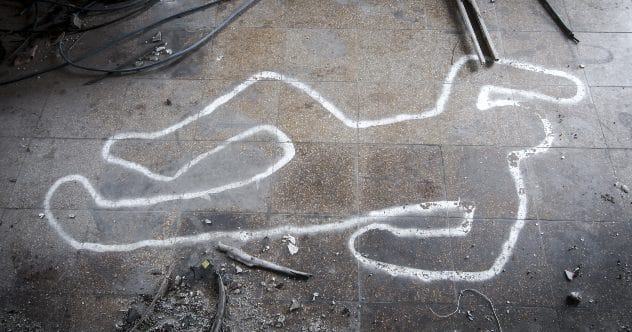Life is full of mysteries, but few are as unsettling as when a suspected criminal dies before their day in court. These premature deaths often leave a trail of unanswered questions, fueling speculation and sometimes, conspiracy theories. Was it a convenient coincidence, a tragic accident, or something more sinister? Join us as we delve into ten perplexing cases where individuals met their end before justice could be served, leaving their stories shrouded in mystery.
10 Henry “Peg” Gilbert
In 1947 Georgia, USA, Henry Gilbert, a 42-year-old successful African-American farmer and father of four, was arrested. Police suspected him of harboring a fugitive wanted for killing a white man. Gilbert, reportedly unaware of the situation, was taken into custody without a warrant and never saw a courtroom. He died in Harris County jail.
The chief of police claimed self-defense, but the mortician’s report told a different story: Gilbert suffered a broken leg, a shattered skull, numerous crushed bones, and had been shot five times. It’s hard to reconcile these injuries with a self-defense claim. Adding to the tragedy, his wife was arrested on the same charges, though they were later dismissed. The brutality of Gilbert’s death and the dubious official account raise dark questions about the events leading to his demise.
9 Federico Garcia Lorca
Federico Garcia Lorca, one of Spain’s most celebrated poets, once wrote, “Only mystery allows us to live.” Ironically, his own death is shrouded in it. Lorca valued art and human connection above political divisions. However, as Spain hurtled towards civil war in July 1936, his sympathies didn’t shield him.
The Nationalist faction disliked Lorca for championing the common people, his modernist views, and his open homosexuality. In August 1936, Nationalist forces arrested him. The very next day, he was driven to a country road and executed. Despite numerous searches, Lorca’s body has never been found. The grounds for his arrest remain unclear, leaving hatred as the most probable, and chilling, motive.
8 Emil Hácha
As World War II loomed, Hitler tightened Germany’s grip on Central Europe. In March 1939, Czechoslovak President Emil Hácha was summoned to Berlin. Hitler presented him with a stark choice: cooperate with German invaders for some autonomy, or resist and face dire consequences.
With the German army poised to advance, Hácha felt he had no choice but to cooperate, ordering his people not to resist. He was installed as president of the German Protectorate of Bohemia and Moravia. Though his role became largely symbolic, Hácha believed he acted in his people’s best interest. The Soviets, however, disagreed. After liberating Prague in May 1945, they arrested Hácha. He died in prison on June 27, awaiting trial. The cause of his death remains unclear, with many, including his family, suspecting assassination.
7 Syama Prasad Mukherjee
Syama Prasad Mukherjee was an influential Indian politician in Nehru’s cabinet during the early years of Indian independence. Political tensions were high, and Mukherjee’s disagreement with Nehru over a pact between India and Pakistan led to his departure. In 1951, he founded a party that was the precursor to today’s BJP.
Mukherjee strongly opposed a law preventing Indian citizens from settling in the disputed Kashmir region. In May 1953, he attempted to enter Kashmir illegally and was arrested. Soon after, he fell ill in prison. A doctor administered a drug Mukherjee claimed was unsuitable for him. Shortly thereafter, he died of a heart attack. Rumors persist that his death was orchestrated by political rivals, effectively silencing him before any trial.
6 Abu Nidal
Abu Nidal, whose real name was Sabri Khalil al-Banna, believed fervently in direct action over negotiation to solve Palestine’s problems. After splitting from Yasser Arafat’s PLO faction, he formed the Abu Nidal Organization, which was linked to terrorist attacks worldwide. Nidal often claimed responsibility for acts his group may have had little involvement in.
He was likely connected to the 1988 bombing of Pan Am Flight 103 over Lockerbie. By 2002, Nidal was in Iraq as the U.S. prepared to invade. When Iraqi intelligence agents came to arrest him, accounts of his death diverge wildly. Some say he shot himself; others claim a gunfight erupted. A third version suggests he was executed by Saddam Hussein’s regime, fearing Nidal might collaborate with Americans. His death, like his life, is mired in controversy.
5 Melissa Caddick
In February 2021, a foot washed up on Bournda Beach in New South Wales, Australia, and was identified as belonging to Melissa Caddick. Caddick had vanished the previous November, a day after police raided her Sydney home. She was suspected of misappropriating around $30 million from investors in a Ponzi scheme operating from 2012 to 2019.
Caddick had duped family, friends, and other clients, depositing their funds into 37 bank accounts to finance a lavish lifestyle, all while providing them with fake statements. Once financial authorities closed in, she disappeared. The discovery of her foot left many theories: suicide, murder, or even a staged death to evade capture. The full story remains elusive.
4 Lee Bradley Brown
British citizen Lee Bradley Brown died in custody in Dubai in 2011. He was on a last-minute holiday at the Burj al Arab hotel. The events in his room are disputed. Hotel staff alleged Brown abused a maid and tried to throw her from a balcony. They claimed he resisted violently, even when authorities intervened. He was charged with intimidation and abusive language.
Brown was initially placed with other European prisoners and seemed to get along with them. However, after a visit to the prosecutor’s office, he returned with serious injuries and was put in solitary confinement. The chief of police first claimed other prisoners beat Brown and offered video evidence, which never materialized. He later denied this, asserting Brown self-harmed. Brown died six days after his arrest, with no clear explanation for his injuries or death.
3 Hans Kammler
Hans Kammler, a high-ranking SS officer and skilled engineer, would undoubtedly have faced trial as a Nazi war criminal if found. He was involved in civil engineering projects, oversaw concentration camp construction, and managed the V-2 rocket program. His rocketry expertise would have been highly valuable to American or Soviet post-war programs.
As WWII concluded, reports of Kammler’s whereabouts conflicted. His driver stated Kammler died around May 10, 1945, but didn’t know how. A former OSS officer claimed the Americans took Kammler to the U.S., where he died in 1947. Other accounts place him in various German locations during the war’s final days. Whether he died in the chaos, was taken by the U.S., or lived out his life elsewhere, he never faced a tribunal.
2 Jeffrey Epstein
Jeffrey Epstein died in New York’s Metropolitan Correctional Center while awaiting trial for sex trafficking. This wasn’t his first brush with the law for sex crimes; he was a convicted offender facing a lengthy sentence if found guilty again.
Days before his death, Epstein was placed on suicide watch after being found unconscious with neck injuries. Protocol dictated he have a cellmate and be checked every 30 minutes. However, on the night he died, these procedures weren’t followed. He was off suicide watch, had no cellmate, and guards reportedly didn’t check his cell. Coincidentally, two cameras monitoring the area malfunctioned. His death, officially ruled a suicide, sparked intense debate about whether he killed himself or was silenced to protect influential associates.
1 Jack Ruby
Jack Ruby adds another layer to the endless conspiracy theories surrounding President John F. Kennedy’s assassination. After authorities arrested Lee Harvey Oswald for Kennedy’s murder, Ruby shot Oswald—on live television—before Oswald could be prosecuted.
Ruby was tried and convicted for Oswald’s killing. He appealed and was granted a new trial. However, Ruby died of cancer before this new trial could commence. The timing and circumstances raise many questions: Why did Ruby kill Oswald? What were his links to organized crime? Why was he granted a retrial? And why did he die so quickly after his diagnosis? These questions remain, fueling speculation about deeper, hidden truths.
The deaths of these individuals before they could face trial leave us with a sense of unease and unresolved justice. Each case is a stark reminder that sometimes, the full story remains hidden, buried with those who took their secrets to the grave.
What are your thoughts on these mysterious deaths? Do you believe there’s more to these stories? Leave your comment below and share your perspective!










